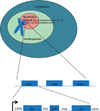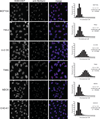Determinants of mammalian nucleolar architecture
- PMID: 25670395
- PMCID: PMC4534358
- DOI: 10.1007/s00412-015-0507-z
Determinants of mammalian nucleolar architecture
Abstract
The nucleolus is responsible for the production of ribosomes, essential machines which synthesize all proteins needed by the cell. The structure of human nucleoli is highly dynamic and is directly related to its functions in ribosome biogenesis. Despite the importance of this organelle, the intricate relationship between nucleolar structure and function remains largely unexplored. How do cells control nucleolar formation and function? What are the minimal requirements for making a functional nucleolus? Here we review what is currently known regarding mammalian nucleolar formation at nucleolar organizer regions (NORs), which can be studied by observing the dissolution and reformation of the nucleolus during each cell division. Additionally, the nucleolus can be examined by analyzing how alterations in nucleolar function manifest in differences in nucleolar architecture. Furthermore, changes in nucleolar structure and function are correlated with cancer, highlighting the importance of studying the determinants of nucleolar formation.
Conflict of interest statement
Conflict of Interest: Katherine I. Farley declares that she has no conflict of interest. Yulia Surovtseva declares that she has no conflict of interest. Janie Merkel declares that she has no conflict of interest. Susan J. Baserga declares that she has no conflict of interest.
Figures



References
-
- Azum-Gelade MC, Noaillac-Depeyre J, Caizergues-Ferrer M, Gas N. Cell cycle redistribution of U3 snRNA and fibrillarin. Presence in the cytoplasmic nucleolus remnant and in the prenucleolar bodies at telophase. Journal of cell science. 1994;107(Pt 2):463–475. - PubMed
Publication types
MeSH terms
Grants and funding
LinkOut - more resources
Full Text Sources
Other Literature Sources

